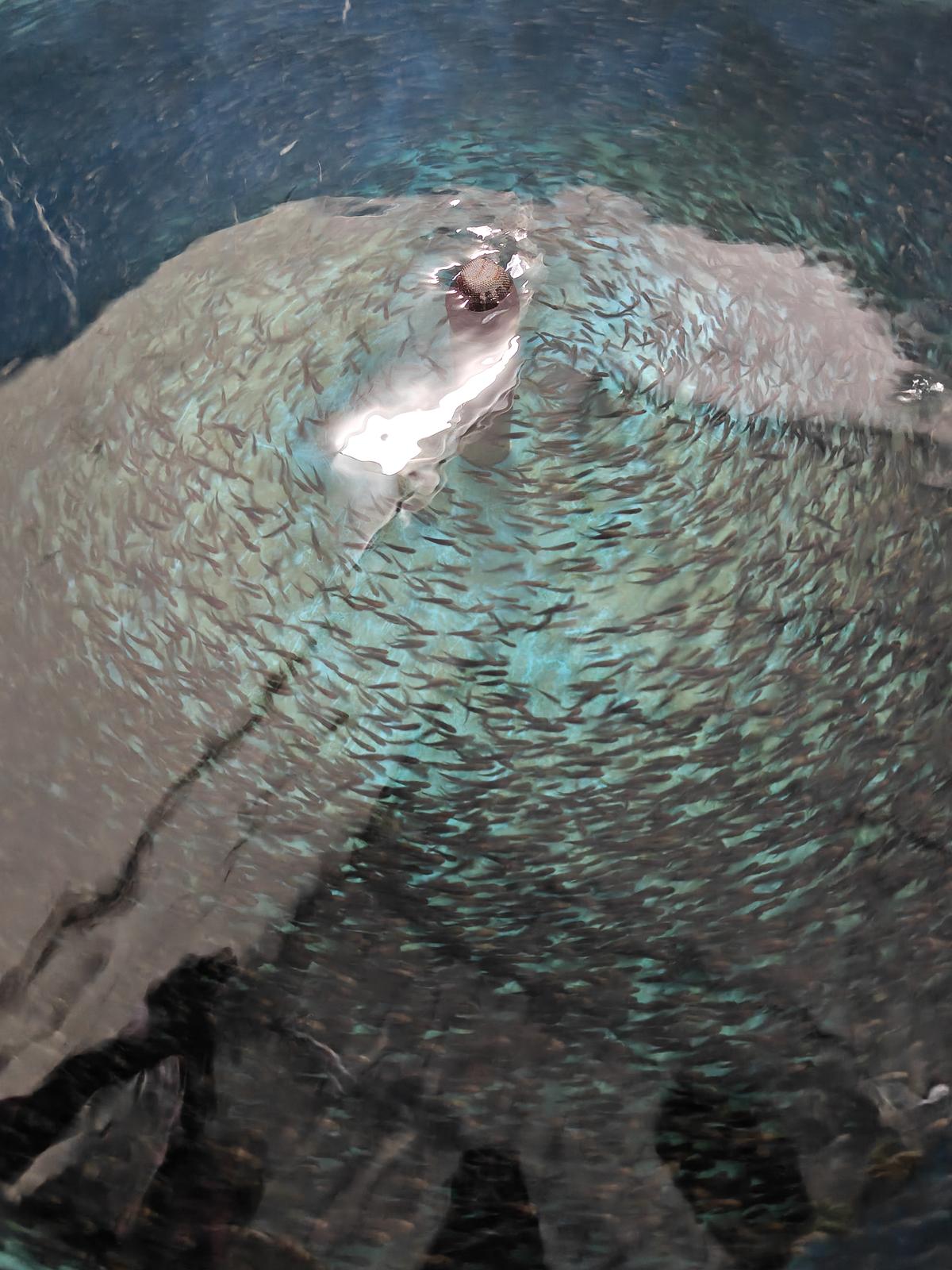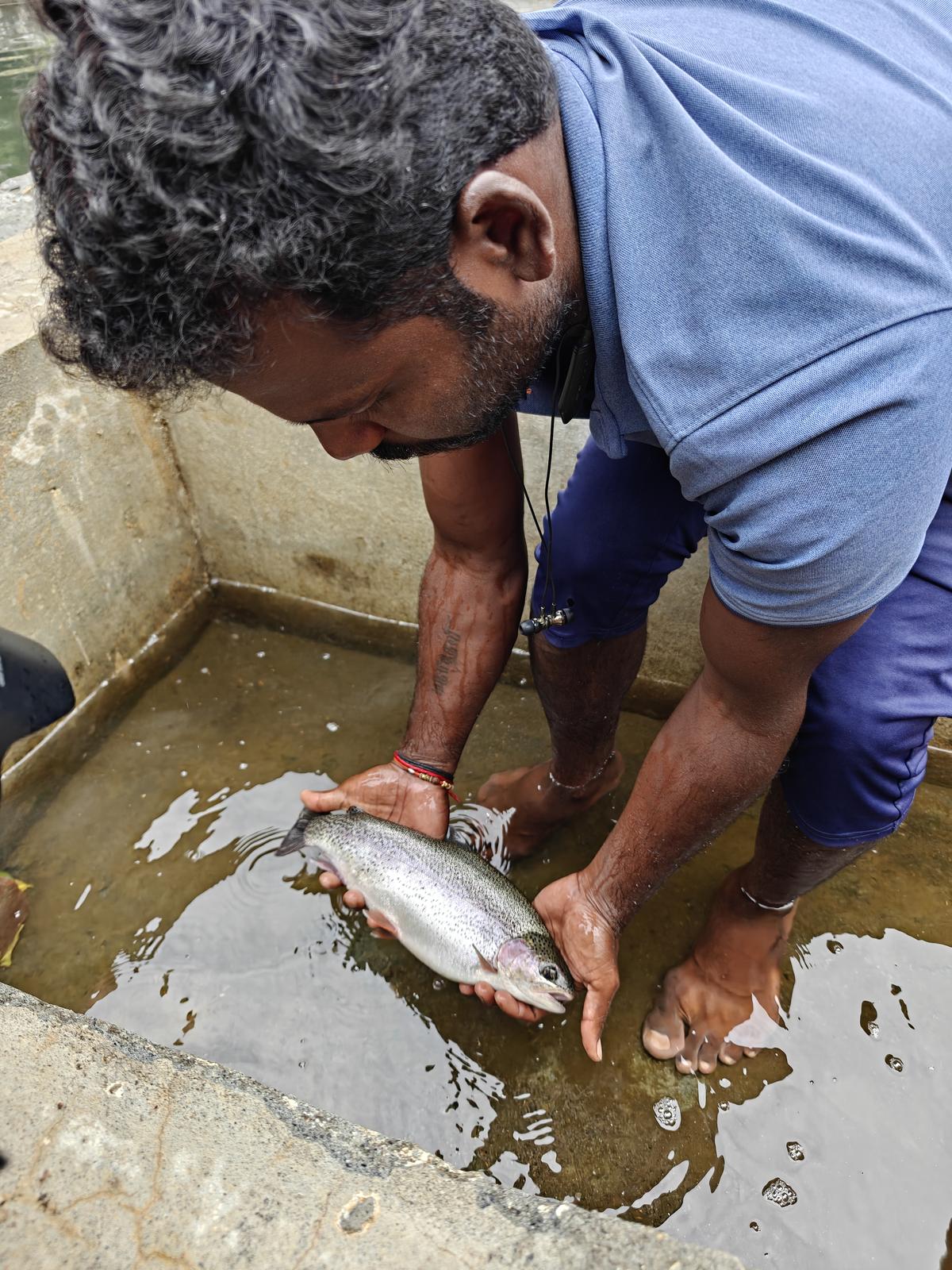
Pink rhododendron blooms at Avalanche. Shot On OnePlus #FramesofIndia
| Photo Credit: K Jeshi
Clear blue waters, rolling grasslands, and gorgeous pink rhododendron blooms abound. That’s Avalanche, a beautiful blue lake located 28 kilometres from Udhagamandalam in The Nilgiris. After a 45-minute drive along rain-washed valleys, and sprawling tea estates, we are at the Avalanche Trout Hatchery & Farm, thrilled to catch a glimpse of the exotic rainbow trout, a cold water fish that thrives in clear, healthy mountain streams and lakes in North America, but now farmed globally.
A fully-grown rainbow trout
| Photo Credit:
SATHYAMOORTHY M
As we stand by the pond, wide-eyed, the trout makes an appearance. It is shimmering in colours of the rainbow, sporting red gills and twinkling eyes. The hatchery, developed by pisciculture expert Henry Charlton Wilson way back in 1907, has been recently renovated and is used for hatching the ‘eyed ova’ of rainbow trout every year. The fingerlings, let in upper reaches of fresh water streams in The Nilgiris, replenishes natural stock of trout.
Kousalya Devi S, Assistant Director of Fisheries at the hatchery in Avalanche
| Photo Credit:
SATHYAMOORTHY M
“It was European settlers who attempted to introduce trout in the pristine streams here in the 19th century,” says Kousalya Devi S, Assistant Director of Fisheries. It was perhaps the Nilgiris Game Fishing Association, which took the initiative of stocking the streams of the Blue Mountains and threw them open to fishing and angling. It has been documented that from 1866 to 1906, several attempts were made to bring eyed ova of trout from various countries, but the efforts failed.

“In 1906, when the then Governor of the State sought the services of Henry Charlton Wilson, he initiated the development of trout fishery in The Nilgiris on a scientific basis. He surveyed the entire district and selected Avalanche stream as the best suited place for a trout hatchery. Hatching technology using artificial breeding was standardised at the lab here,” she says adding that the first batch of trout from New Zealand was hatched successfully here. In 1943, 25,000 eyed ova were brought from Sri Lanka while in 1960 another 20,00 came from Kashmir. In 1974, as many as 10,000 ova of albino rainbow trout were brought as a gift and introduced in the hatchery.

Trout fingerlings at the hatchery. Shot On OnePlus #FramesofIndia
| Photo Credit:
K Jeshi
“The rainbow-tinted body looks magical as it swirls around in running fresh water,” says Kousalya adding that they collected three lakh trout eggs in eyed ova stage from Asia’s largest trout farm in Kashmir. “By bringing eggs from Kashmir, we have restarted a tradition that has its origins some 100 years ago. It’s an 18-day-old ova. In this stage, it can survive for four days without water during which we air transport the boxes. As October to February is the breeding season, we made two trips to Kashmir to collect the best eggs,” she explains.

In India, due to weather constraints, trout farming is limited to the upper Himalayan region and the Western Ghats. The hydro electric reservoirs are particularly suitable as trout thrive in healthy fresh waters and in temperatures between 0 to 20 degrees Celsius. It cannot flourish in standing water and must have access to perennially flowing waters. “The Forest Protection Act (1972) brought a dramatic shift in trout fishery. The water streams of hydroelectric power projects, like Mukurthi Reservoir earmarked as ‘carp waters’ (another variety of fish) and ‘trout waters’ where these fish varieties thrived, became out of bounds,” says Kousalya adding that it reduced the hatchery to a mere heritage structure.

A new lease of life
A proposal with the Special Area Development Project for replenishing trout stocks has now given it a fresh lease of life. “We sourced high protein pellets in varying sizes for different stages to ensure better survival. The fish is also cannibalistic, so only the fittest survive. Of the three lakh eggs, the survival rate has been 55 per cent,” explains Kousalya.

High protein pellets in varying sizes are used as feed for different stages. Shot On OnePlus #FramesofIndia
| Photo Credit:
K Jeshi
While in Kashmir, trout farming in the backyard is a big draw among tourists, the Avalanche hatchery, the only trout hatchery in South India is taking baby steps. “Once commercial Recirculatory Aquaculture System is in place, it helps farmers use water judiciously. We still have a long way to go. In Kashmir, tourists stay at guest houses at apple orchards, enjoy trout fishing in the streams in the backyard where the locals also engage in trout culture. Once we standardise seed production, we can choose farms in suitable locations like Korakundah. We can educate and train farmers in commercial trout culture.”

A close-up of pink rhododendron. Shot On OnePlus #FramesofIndia
| Photo Credit:
K Jeshi
Trout is also rich in protein and omega-3 fatty acids, another reason for its popularity. “The meat is buttery and has a delicate taste. It can be grilled or smoked and is one of the most popular fish in European cuisines,” she says, adding, “Trout is an indicative species. When you eat trout, you can be sure that it has come from a place where the environment is still healthy and water is pollution-free.”
Published – April 26, 2025 04:11 pm IST





